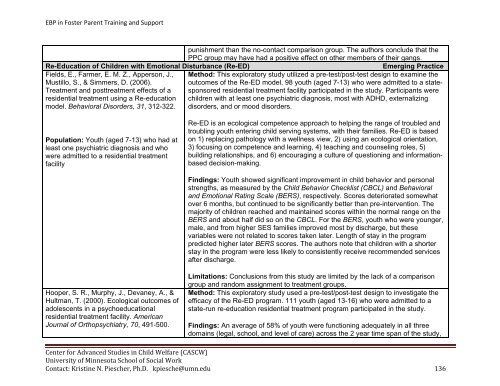Evidence-Based Practice in Foster Parent Training and Support ...
Evidence-Based Practice in Foster Parent Training and Support ...
Evidence-Based Practice in Foster Parent Training and Support ...
You also want an ePaper? Increase the reach of your titles
YUMPU automatically turns print PDFs into web optimized ePapers that Google loves.
EBP <strong>in</strong> <strong>Foster</strong> <strong>Parent</strong> Tra<strong>in</strong><strong>in</strong>g <strong>and</strong> <strong>Support</strong>punishment than the no-contact comparison group. The authors conclude that thePPC group may have had a positive effect on other members of their gangs.Re-Education of Children with Emotional Disturbance (Re-ED) Emerg<strong>in</strong>g <strong>Practice</strong>Fields, E., Farmer, E. M. Z., Apperson, J.,Mustillo, S., & Simmers, D. (2006).Treatment <strong>and</strong> posttreatment effects of aresidential treatment us<strong>in</strong>g a Re-educationmodel. Behavioral Disorders, 31, 312-322.Method: This exploratory study utilized a pre-test/post-test design to exam<strong>in</strong>e theoutcomes of the Re-ED model. 98 youth (aged 7-13) who were admitted to a statesponsoredresidential treatment facility participated <strong>in</strong> the study. Participants werechildren with at least one psychiatric diagnosis, most with ADHD, externaliz<strong>in</strong>gdisorders, <strong>and</strong> or mood disorders.Population: Youth (aged 7-13) who had atleast one psychiatric diagnosis <strong>and</strong> whowere admitted to a residential treatmentfacilityRe-ED is an ecological competence approach to help<strong>in</strong>g the range of troubled <strong>and</strong>troubl<strong>in</strong>g youth enter<strong>in</strong>g child serv<strong>in</strong>g systems, with their families. Re-ED is basedon 1) replac<strong>in</strong>g pathology with a wellness view, 2) us<strong>in</strong>g an ecological orientation,3) focus<strong>in</strong>g on competence <strong>and</strong> learn<strong>in</strong>g, 4) teach<strong>in</strong>g <strong>and</strong> counsel<strong>in</strong>g roles, 5)build<strong>in</strong>g relationships, <strong>and</strong> 6) encourag<strong>in</strong>g a culture of question<strong>in</strong>g <strong>and</strong> <strong>in</strong>formationbaseddecision-mak<strong>in</strong>g.F<strong>in</strong>d<strong>in</strong>gs: Youth showed significant improvement <strong>in</strong> child behavior <strong>and</strong> personalstrengths, as measured by the Child Behavior Checklist (CBCL) <strong>and</strong> Behavioral<strong>and</strong> Emotional Rat<strong>in</strong>g Scale (BERS), respectively. Scores deteriorated somewhatover 6 months, but cont<strong>in</strong>ued to be significantly better than pre-<strong>in</strong>tervention. Themajority of children reached <strong>and</strong> ma<strong>in</strong>ta<strong>in</strong>ed scores with<strong>in</strong> the normal range on theBERS <strong>and</strong> about half did so on the CBCL. For the BERS, youth who were younger,male, <strong>and</strong> from higher SES families improved most by discharge, but thesevariables were not related to scores taken later. Length of stay <strong>in</strong> the programpredicted higher later BERS scores. The authors note that children with a shorterstay <strong>in</strong> the program were less likely to consistently receive recommended servicesafter discharge.Hooper, S. R., Murphy, J., Devaney, A., &Hultman, T. (2000). Ecological outcomes ofadolescents <strong>in</strong> a psychoeducationalresidential treatment facility. AmericanJournal of Orthopsychiatry, 70, 491-500.Limitations: Conclusions from this study are limited by the lack of a comparisongroup <strong>and</strong> r<strong>and</strong>om assignment to treatment groups.Method: This exploratory study used a pre-test/post-test design to <strong>in</strong>vestigate theefficacy of the Re-ED program. 111 youth (aged 13-16) who were admitted to astate-run re-education residential treatment program participated <strong>in</strong> the study.F<strong>in</strong>d<strong>in</strong>gs: An average of 58% of youth were function<strong>in</strong>g adequately <strong>in</strong> all threedoma<strong>in</strong>s (legal, school, <strong>and</strong> level of care) across the 2 year time span of the study,Center for Advanced Studies <strong>in</strong> Child Welfare (CASCW)University of M<strong>in</strong>nesota School of Social WorkContact: Krist<strong>in</strong>e N. Piescher, Ph.D. kpiesche@umn.edu 136
















